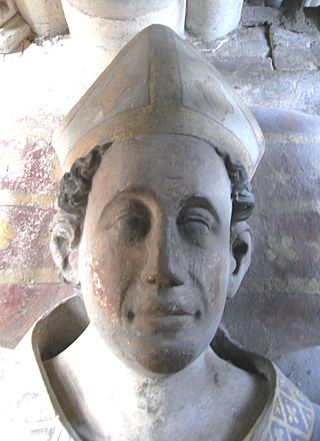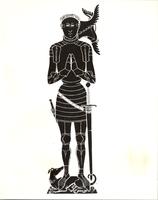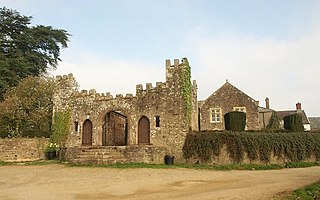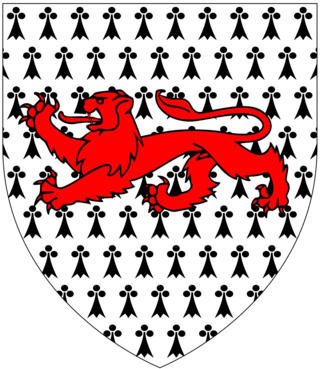Semper fidelis is a Latin phrase that means "always faithful" or "always loyal". It is the motto of the United States Marine Corps, usually shortened to Semper Fi. It is also in use as a motto for towns, families, schools, and other military units.

Earl of Devon was created several times in the English peerage, and was possessed first by the de Redvers family, and later by the Courtenay family. It is not to be confused with the title of Earl of Devonshire, held, together with the title Duke of Devonshire, by the Cavendish family of Chatsworth House, Derbyshire, although the letters patent for the creation of the latter peerages used the same Latin words, Comes Devon(iae). It was a re-invention, if not an actual continuation, of the pre-Conquest office of Ealdorman of Devon.

Walter de Stapledon was Bishop of Exeter 1308–1326 and twice Lord High Treasurer of England, in 1320 and 1322. He founded Exeter College, Oxford and contributed liberally to the rebuilding of Exeter Cathedral. His tomb and monument, of great architectural importance, survives in Exeter Cathedral. He was killed by a mob during the London uprising.

Peter Courtenay was Bishop of Exeter (1478–87) and Bishop of Winchester (1487-92), and also had a successful political career during the tumultuous years of the Wars of the Roses.
Devon was a parliamentary constituency covering the county of Devon in England. It was represented by two Knights of the Shire, in the House of Commons of England until 1707, then of the House of Commons of Great Britain from 1707 to 1800 and finally the House of Commons of the United Kingdom from 1801 to 1832. Elections were held using the bloc vote system of elections.

Sir Hugh de Courtenay, 2nd/10th Earl of Devon, 2nd Baron Courtenay, feudal baron of Okehampton and feudal baron of Plympton, played an important role in the Hundred Years War in the service of King Edward III. His chief seats were Tiverton Castle and Okehampton Castle in Devon. The ordinal number given to the early Courtenay Earls of Devon depends on whether the earldom is deemed a new creation by the letters patent granted 22 February 1334/5 or whether it is deemed a restitution of the old dignity of the de Redvers family. Authorities differ in their opinions, and thus alternative ordinal numbers exist, given here.
The High Sheriff of County Galway was the Sovereign's judicial representative in County Galway. Initially an office for lifetime, assigned by the Sovereign, the High Sheriff became annually appointed from the Provisions of Oxford in 1258. Besides his judicial importance, he had ceremonial and administrative functions and executed High Court Writs.

Sir Richard Warwick Bampfylde, 4th Baronet of Poltimore, North Molton, Warleigh, Tamerton Foliot and Copplestone in Devon and of Hardington in Somerset, England, was Member of Parliament for Exeter (1743–47) and for Devonshire (1747–76).
Efford is an historic manor formerly in the parish of Eggbuckland, Devon, England. Today it has been absorbed by large, mostly post-World War II, eastern suburb of the city of Plymouth. It stands on high ground approximately 300 feet above the Laira estuary of the River Plym and provides views over long distances: to the north across Dartmoor, to the east and south-east across the South Hams. It consists predominantly of local authority and housing association properties. Before this land was built upon it was known as 'The Wilds of Efford', and was largely unspoilt countryside and marsh land. That a deer park may have been attached to the manor is suggested by the survival of the street name "Deer Park Drive".

Thomas de Courtenay, 5th/13th Earl of Devon was a nobleman from South West England. His seat was at Colcombe Castle near Colyton, and later at the principal historic family seat of Tiverton Castle, after his mother's death. The Courtenay family had historically been an important one in the region, and the dominant force in the counties of Devon and Cornwall. However, the rise in power and influence of several gentry families and other political players, in the years leading up to Thomas' accession to the earldom, threatened the traditional dominance of the earls of Devon in the area. Much of his life was spent in armed territorial struggle against his near-neighbour, Sir William Bonville of Shute, at a time when central control over the provinces was weak. This feud forms part of the breakdown in law and order in England that led to the Wars of the Roses.
Sir Richard Reynell, of Pitney in the county of Somerset, Sheriff of Devon in 1191-4, was a knight who lived during the successive reigns of Kings Henry II (1154-1189), Richard I (1189-1199) and John (1199-1216).

Edward Drew (c.1542–1598) of Killerton, Broadclyst and The Grange, Broadhembury, Devon, was a Serjeant-at-Law to Queen Elizabeth I. He served as a Member of Parliament for Lyme Regis in 1584, twice for Exeter in 1586 and 1588 and in 1592 for the City of London. He occupied the honourable position of Recorder of the City of London.

The landed gentry and nobility of Devonshire, like the rest of the English and European gentry, bore heraldic arms from the start of the age of heraldry circa 1200–1215. The fashion for the display of heraldry ceased about the end of the Victorian era (1901) by which time most of the ancient arms-bearing families of Devonshire had died out, moved away or parted with their landed estates.

The Manor of Poltimore is a former manor in Devon, England. The manor house known as Poltimore House survives in its 18th-century remodelled form, but has been dilapidated for several decades. A charity named the "Poltimore House Trust" has been established for the purpose of its restoration. The manor was situated within the historic Wonford Hundred and was largely coterminous with the parish of Poltimore and contained the village of Poltimore, 4 miles (6.4 km) north-east of the historic centre of the City of Exeter. It should not be confused with the eponymous Devon estate of Poltimore in the parish of Farway, 16 miles (26 km) east of Exeter. Poltimore was the principal seat of the Bampfylde family from c. 1300 to 1920.

Sir John St Leger of Ulcombe in Kent, was Sheriff of Kent in 1430 and 1433.

West Ogwell is a village and former civil parish and manor, now in the parish of Ogwell, in the Teignbridge district, in the county of Devon, England. It is located 2 miles south-west of the town of Newton Abbot and 1 mile west of the village of East Ogwell. The church and manor house "lie hidden away on their own". In 1891 the parish had a population of 39. In 1894 the parish was abolished and merged with East Ogwell to form "Ogwell".

Dowrich is an historic estate in the parish of Sandford, on the River Creedy, three miles north-east of Crediton in Devon, England. Between the 12th century and 1717 it was the seat of the ancient gentry family of Dowrish which took its name from the estate where it had become established before the reign of King John (1199–1216), when it built a castle keep on the site. A 15th century gatehouse survives there today, next to the ancient mansion house.

The Drewe family of Broadhembury are generation owners and inhabitants of The Grange, Sharpham, Broadhembury, Wadhurst Park, Devon, in the west and east of England, from the 16th century to the current date.
The Recorder of Exeter was a recorder, a form of senior judicial officer, usually an experienced barrister, within the jurisdiction of the City of Exeter in Devon. Historically he was usually a member of the Devonshire gentry. The position of recorder of any borough or city carried a great deal of prestige and power of patronage. The recorder was often entrusted by the mayor and corporation to nominate its members of parliament, as was the case with Sir Hugh I Pollard, Recorder of Barnstaple, who in 1545 nominated the two MP's to represent the Borough of Barnstaple. In the 19th century a recorder was the sole judge who presided at a Quarter Sessions of a Borough, a "Court of Record", and was a barrister of at least five years' standing. He fixed the dates of the Quarter Sessions at his own discretion "as long as he holds it once every quarter of a year", or more often if he deemed fit.

Robert Bastard (fl.1086) was a Norman warrior who assisted in the 1066 Norman Conquest of England under King William the Conqueror. He was subsequently rewarded with landholdings in Devonshire and is one of the Devon Domesday Book tenants-in-chief of that monarch, with a holding of 10 manors or estates held in chief, 8 of which he held in demesne, i.e. under his own management without tenants. He had at least one further holding as a mesne tenant, at Goosewell, Plymstock parish, Plympton hundred, held from William of Poilley, a Norman tenant-in-chief from Poilley in Normandy, most of whose 21 landholdings were later granted by King Henry I (1100–1135) to his trusted supporter Richard de Redvers, feudal baron of Plympton in Devon.














